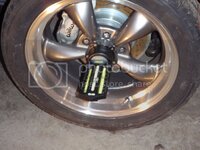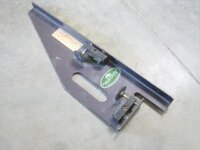vette427sbc
Well-known member
So I did my first auto-x after changing a few things on the vette (larger/wider wheels, raised diff, and tall ball joint UCA's)
I was really impressed with how everything performed considering all of my spring rate, and alignment settings were either eyeballed or left the same from the previous setup.
Anyway, heres what I noticed...
Dual mount spring in the rear- Hardest spring setting. Loved it. Significantly less body roll (no rear sway) compared to the 3rd hardest setting. Did not change alignment other than raising the diff which probably reduced my (-) camber a bit.
Dual mount front spring with 1.125" sway and tall ball joint UCA's- 2nd softest spring setting- Low speed turns the car was pushing pretty bad unless I gassed it to swing the rear around. Higher speed, it was the rear that would let out first. Last time I checked, I have 0 toe. Eyeballed camber, and castor settings :tomato: Tires were noticeably hotter(by hand) on the outside.
I actually really liked how the rear behaved (predictable and easy to control oversteer!) and I think I will leave that alone for now. But the front seems like it doesnt have enough (-) camber. This is a street car, so I dont want to run alot of static camber. Can the the high speed/low speed differences be tuned out or do I have to make a compromise? I have to find some time to get it on a real alignment rack to see where Im really at.
And to brag just a little... fastest time of the day was an instructor with 44.5 seconds in an S2000. I managed a 46.5 on my last run. Definitely brought my spirits up! :thankyou:
I was really impressed with how everything performed considering all of my spring rate, and alignment settings were either eyeballed or left the same from the previous setup.
Anyway, heres what I noticed...
Dual mount spring in the rear- Hardest spring setting. Loved it. Significantly less body roll (no rear sway) compared to the 3rd hardest setting. Did not change alignment other than raising the diff which probably reduced my (-) camber a bit.
Dual mount front spring with 1.125" sway and tall ball joint UCA's- 2nd softest spring setting- Low speed turns the car was pushing pretty bad unless I gassed it to swing the rear around. Higher speed, it was the rear that would let out first. Last time I checked, I have 0 toe. Eyeballed camber, and castor settings :tomato: Tires were noticeably hotter(by hand) on the outside.
I actually really liked how the rear behaved (predictable and easy to control oversteer!) and I think I will leave that alone for now. But the front seems like it doesnt have enough (-) camber. This is a street car, so I dont want to run alot of static camber. Can the the high speed/low speed differences be tuned out or do I have to make a compromise? I have to find some time to get it on a real alignment rack to see where Im really at.
And to brag just a little... fastest time of the day was an instructor with 44.5 seconds in an S2000. I managed a 46.5 on my last run. Definitely brought my spirits up! :thankyou:


